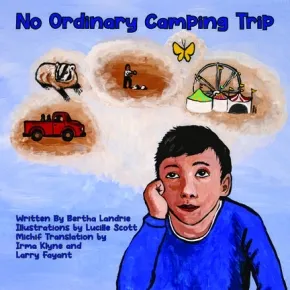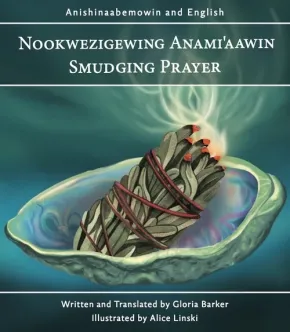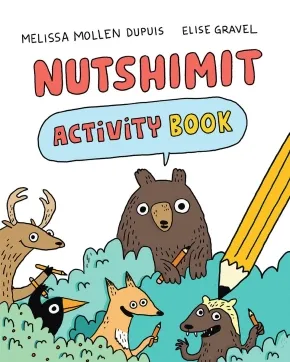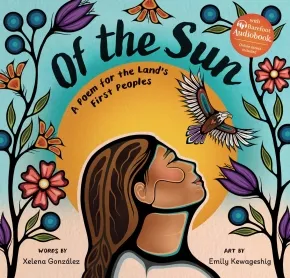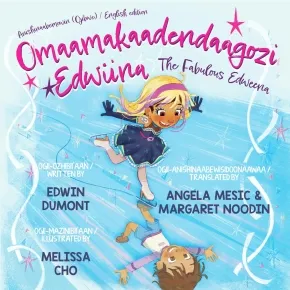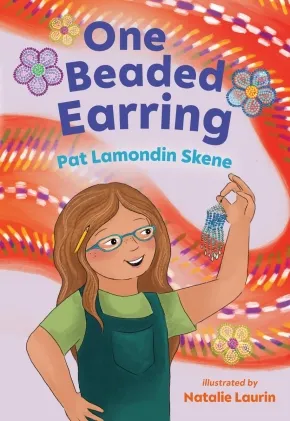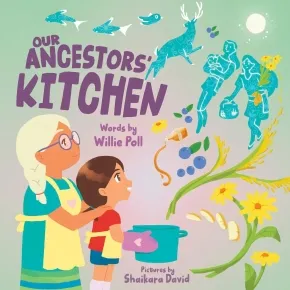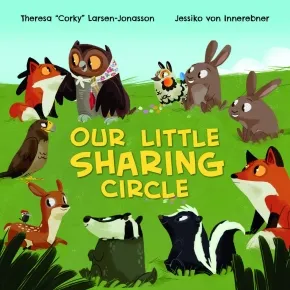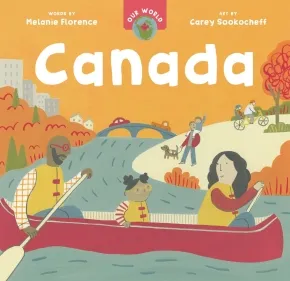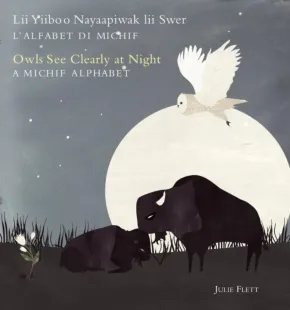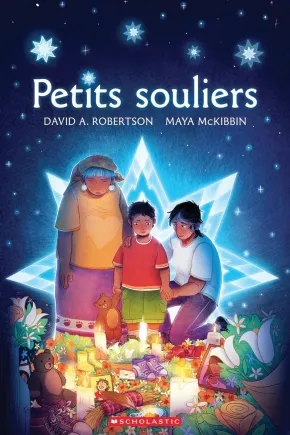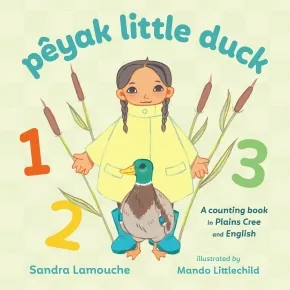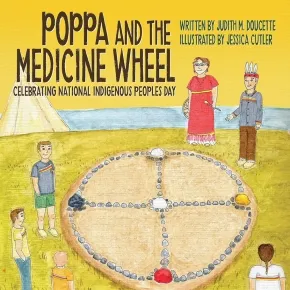
Indigenous Peoples in Canada
91
-
105
of
1317 Results;
Sort By
Go To
of 88
No Ordinary Camping Trip
$17.50
Artists:
Format:
Paperback
Text Content Territories:
Indigenous Canadian; Métis;
ISBN / Barcode: 9781988011363
Synopsis:
Synopsis:
In No Ordinary Camping Trip, Bertha Landrie recounts a tale from her husband, Joe’s, childhood. Many Métis families relied on seasonal employment, working for farmers, clearing fields, picking Seneca root, and other labour jobs to support themselves. In this coming-of-age story, a young Joe works hard picking rocks in order to make money to go to the North Battleford Fair. Will they be able to finish the job in time? Lucille Scott’s evocative illustrations take us back in time while capturing the story’s essence. Michif Old Ones, Irma Klyne and Larry Fayant provide a Southern Michif translation—the language of the Landrie family.
Reviews
"Rich in cultural detail, the story introduces young readers to aspects of Métis culture and values. The book celebrates themes of family, resilience, and identity. Suitable for grades three to five Social Studies and Language Arts, it supports curricular goals related to Indigenous perspectives, cultural diversity, and belonging, while promoting early bilingual literacy through its inclusion of Michif. Narrations in English and Michif are available through a link provided by the publisher, and supplementary information about the Road Allowance period in Métis history is also provided." - Bonny-Lynn D., Elementary School Teacher, Indigenous Books for Schools
Educator Information
Recommended for Grades 3 to 5.
Dual-language format: Michif and English.
Themes: Childhood; Coming of Age; Family; Intergenerational Roles
This title is included in the Indigenous Books for Schools database from the Association of Book Publishers of BC. It's recommended for Grades 3 to 5 for English Language Arts and Social Studies.
Additional Information
37 Pages | 9" x 9" | Paperback
Nookwezigewing anami'aawin / Smudging Prayer
$9.99
Artists:
Format:
Paperback
Text Content Territories:
Indigenous Canadian; First Nations; Anishinaabeg; Ojibway; Hollow Water First Nation (Waanibiigaaw / Wanipigow);
ISBN / Barcode: 9781779550224
Synopsis:
Synopsis:
Written by Gloria Barker, Language Teacher from Hollow Water First Nation, which is located on the east side of Lake Winnipeg, Canada. Hollow Water First Nation is also known as Waanibiigaaw or Wanipigow in Ojibwe. Illustrated by Alice Linski; Alice RL is a member of Ne-biimiskonaan (Skownan) First Nation, Treaty 2 Territory. Alice is a Two-Spirit Anishinaabe artist, illustrator, and art teacher based in Winnipeg, Manitoba. Alice draws inspiration from life experiences and cultural teachings. Alice blends these inspirations with a signature palette of bright, playful hues to create stunning emotional juxtapositions of trauma and grief with hope and a touch of whimsy.
Educator Information
The publisher recommends this work for all ages.
This book is delivered in a dual-language format of Anishinaabemowin and English.
This book is also available in English: Smudging Prayer
Additional Information
Paperback
Nutshimit: Activity Book
$18.99
Artists:
Format:
Paperback
Text Content Territories:
Indigenous Canadian; Métis; Inuit; First Nations; Innu (Montagnais-Naskapi);
ISBN / Barcode: 9781039711778
Synopsis:
Synopsis:
Add your favourite toppings to the bannock, draw some animals that live in the woods and write down a joke that would make cranky Wolverine laugh!
With almost 90 big pages of creative fun based on the bestselling Nutshimit: In the Woods, written by Melissa Mollen Dupuis and illustrated by Elise Gravel, this activity book encourages children to learn and have fun with nature.
Includes colouring pages, word searches, connect-the-dots, picture-prompts, spot-the-differences, DIY comic pages and much more to keep young forest enthusiasts engaged and entertained.
Educator Information
Recommended for ages 6 to 8.
Find the accompanying book here: Nutshimit: In the Woods
This activity book is available in French: Nutshimit: Le cahier d'activités
Additional Information
96 pages | 8.01" x 9.99" | Paperback
Of the Sun: A Poem for the Land's First Peoples
$22.99
Format:
Hardcover
Text Content Territories:
Indigenous American; Indigenous Canadian; Indigenous Caribbean; Indigenous Peoples in Mexico; Indigenous South American;
Grade Levels: Preschool; Kindergarten;
ISBN / Barcode: 9798888596500
Synopsis:
Synopsis:
A powerful and hopeful ode to Indigenous children.
Indigenous. Native. On this land, you may roam.
Child of the sun, on this land, you are home.
Of the Sun is an uplifting and mighty poem that wraps the Indigenous children of the Americas in reassuring words filled with hope for a brighter future and reminders of their bond and importance to the land. Each page fills them with pride and awe of their cultural heritage and invites them to unite and inspire change in the world.
Paired with powerful art reflecting cultures of various Indigenous Nations and Tribes, the poem offers all readers a sense of the history and majesty of the land we live on and how we can better care for ourselves and the world when we recognize our connection to the land and to each other.
Written by Xelena González, poet and activist in the Native and Latinx communities, and an enrolled member of the Tap Pilam Coahuiltecan Nation. Bold illustrations by prominent Anishinaabe illustrator Emily Kewageshig depict landscapes across the Americas and children from many backgrounds
Endnotes provide more information on Native and Indigenous unity and activism in younger generations
Reviews
"Of The Sun is a loving homage to the Indigenous peoples of this land—both in González’s beautiful, lyrical poem and Kewageshig’s warm, vibrant Anishinaabe-styled artwork. A wonderful read aloud you must add to bookshelves at home, at school, and in community!" - Traci Sorell, award-winning author of We Are Grateful Otsaliheliga and At The Mountain’s Base
"A luminous song, poem, promise
of cultures and connection,
of kinship and caring,
for Indigenous children across the continent." - Cynthia Leitich Smith, author of Jingle Dancer
Educator Information
Recommended for ages 3 to 5.
Subjects / Themes / Topics Included: Indigenous Peoples in the Americas; Poetry; Land Connection; Inuit Clothing; Traditional Hair Bun (tsiiyéél); Concheros Dance; Three Sisters; La Danza de la Flor de Piña; Smoke Dance; Jingle Dress Dance; Manoomin (Wild Rice); English Words from Indigenous Languages; Indigenous Farming Practices; Bison; Land Back Movement.
Additional Information
32 pages | 10.00" x 9.75" | Hardcover
Omaamakaadendaagozi Edwiina / The Fabulous Edweena
$21.95
Artists:
Format:
Hardcover
Text Content Territories:
Indigenous Canadian; First Nations; Anishinaabeg; Ojibway;
ISBN / Barcode: 9781772604078
Synopsis:
Synopsis:
Edwin loves his sister Patsy's closet. He adores dresses and earrings and boots with high heels. And when he's finished getting dressed, Edwin is transformed...into the fabulous Edweena!
Today is the figure skating competition at school and Edwin has decided to compete as Edweena. What will people say when they meet her for the first time? Can a boy in drag win the competition? Edweena will have to give her best performance ever to find out!
Reviews
"Edwin Dumont’s The Fabulous Edweena is written in English and celebrates the Anishinaabemowin (Ojibwe) language through translations by Angela Mesic and Margaret Noodin. Inspired by Dumont’s own childhood experiences—including dressing up in his sisters’ clothes—the story follows Edweena as she prepares for a local figure skating competition. Though nervous about how others might react, Edweena sees the event as a chance to express herself through drag. Cautiously, she takes to the ice in her sisters’ clothes—and is met with unexpected support and encouragement. This heartwarming story highlights the courage it takes to be true to yourself and reminds readers that authenticity, even when scary, can lead to acceptance and joy." - Debra H., Elementary School Teacher, Indigenous Books for Schools
Educator Information
Recommended for ages 6 to 8.
Dual-language: Anishinaabemowin (Ojibwe) and English.
This book is available in English: The Fabulous Edweena
This title is included in the Indigenous Books for Schools database from the Association of Book Publishers of BC. It is recommended for Grades 1 to 3 for English Language Arts and Physical and Health Education.
Additional Information
24 pages | 8.50" x 8.50" | Hardcover
On y va!
$21.95
Artists:
Format:
Hardcover
Text Content Territories:
Indigenous Canadian; First Nations; Cree (Nehiyawak);
ISBN / Barcode: 9782897771706
Synopsis:
Synopsis:
Chaque jour, un petit garçon regarde des enfants passer en planche à roulettes et rêve de les rejoindre. Un jour, sa mère lui apporte une surprise : sa vieille planche, juste pour lui ! haw êkwa ! On y va ! Ensemble, ils le font, pratiquant sur le trottoir, au parc — partout. Mais quand vient le moment de pratiquer au parc, les planchistes dévalent les pentes comme une cascade. Pourra-t-il trouver la confiance pour les rejoindre?
Reviews
“L’album s’installe dans la chaleur de ce partage, et dans l’ivresse de leur essor. Il suit l’évolution d’un garçon d’abord paralysé par la timidité, puis électrisé par la confiance en soi.”— Télérama
“Julie Flett signe ici un somptueux quatrième album qui regorge d’émotions et qui fait honneur à l’amitié et à la persévérance. Avec ses pastels, Julie Flett exprime aussi la joie de vivre, le plaisir de s’exercer à ce sport, à cette passion qu’elle aime partager avec ses lecteur·rice·s!”— Lu et partagé
“La liberté de la déambulation en skateboard faite livre. [...] Crie-métisse, l’autrice-illustratrice Julie Flett mêle l’apprentissage de l’exercice d’un sport à celle d’une langue.”— Maze
Educator Information
Recommended for ages 6 to 8.
Curriculum Connections: Sports / Indigenous Languages / Community / Goal-Setting / Risk-Taking / Self-Awareness / Self-Confidence
This book is available in English: Let's Go! haw êkwa
Additional Information
44 pages | 11.00" x 9.00" | Hardcover
One Beaded Earring
$8.95
Artists:
Format:
Paperback
Text Content Territories:
Indigenous Canadian; Métis;
ISBN / Barcode: 9781459841598
Synopsis:
Synopsis:
Delia’s mom has the most beautiful earrings.
They’re long and dangly earrings, and made from strands upon strands of tiny blue, green and white beads that make the earrings look like waterfalls. Delia decides to wear the earrings to school to show off a little to her friends. And it works—until one earring falls down the drain in the school bathroom.
When Delia confides in her grandmother about the lost earring, she learns that she can’t just replace it: her Aunt Maureen made the earrings for her mother to celebrate getting their Métis citizenship. Delia didn’t even know her family was Métis! With no way to replace the lost earring, Delia must own up to her mistakes, dive deeper into her Métis identity and use her storytelling skills to find a way to make things right.
Educator & Series Information
Recommended for ages 6 to 8.
Fountas & Pinnell Text Level Gradient: N
Lexile measure: 610L
Flesch-Kincaid Grade Level: 3.5
Guided Reading Level: N
This book is part of the Orca Echoes series.
Includes a Michif glossary.
Additional Information
96 pages | 5.25" x 7.62" | 27 b&w illustrations | Paperback
Our Ancestors' Kitchen
$23.99
Format:
Hardcover
Text Content Territories:
Indigenous Canadian;
ISBN / Barcode: 9781773219622
Synopsis:
Synopsis:
A poignant and poetic picture book celebrating traditional Indigenous harvesting, foods, and the connections that these build for all our relations.
It’s a special day: the young protagonist in this memorable story is learning her grandfather’s favorite recipe from her grandmother! As each ingredient is prepared for this special dish, readers will be eager to follow along as they are transported back to each instance of gathering, hunting, and harvesting foods in the traditional ways throughout the seasons.
Willie Poll’s poetic voice leads the readers through the seasons and what Mother Earth offers to us in nature in this beautiful celebration of the Earth, our foods, our family, and the importance of grieving those we love. With an emphasis on the importance of thanking the land for what is given to us, sharing with our community, and offering a plate to our ancestors, this gentle and thoughtful tale will resonate with readers young and old alike. Shaikara David’s bright and inviting illustrations carry the cooking experience from the kitchen, to the forest, and back again.
Featuring an author’s note on traditional harvesting practices and a recipe for Nuwish, Our Ancestors’ Kitchen is a joyous exploration of love, food, and culture.
Educator Information
Recommended for ages 4 to 7.
Additional Information
36 pages | 9.75" x 9.75" | Hardcover
Our Little Sharing Circle (BB)
$13.95
Artists:
Format:
Board Book
Text Content Territories:
Indigenous Canadian; First Nations;
ISBN / Barcode: 9781778540769
Synopsis:
Synopsis:
In our little sharing circle…We care…We share… Our Little Sharing Circle is a gentle introduction to sharing, listening, and learning in the sharing circle. Our Little Sharing Circle is based on the bestselling picture book, The Sharing Circle.
Educator Information
Recommended for ages 3 and under.
This book is based on the picture book The Sharing Circle.
Additional Information
10 pages | 6.00" x 6.00" | Board Book
Our World: Canada (BB)
$12.99
Artists:
Format:
Board Book
Text Content Territories:
Indigenous Canadian; First Nations; Cree (Nehiyawak);
Grade Levels: Preschool;
ISBN / Barcode: 9798888596685
Synopsis:
Synopsis:
Good morning! Bonjour! Tānisi! Spend a day in Canada. Eat soft crepes with sticky maple syrup, play with atimwak in the snow and cache-cache in the park, and zip and zoom around the ice rink. Even learn words in French and Cree with pronunciation guides throughout the story.
Endnotes provide more insights into life in Canada.
Educator Information
Recommended for ages 2 and 3.
This book includes multicultural content about life in Canada. It includes some French and Cree words/phrases.
Additional Information
20 pages | 6.70" x 6.50" | Boardbook
Owls See Clearly at Night/Lii Yiiboo Nayaapiwak lii Swer: A Michif Alphabet/L'Alfabet Di Michif
$25.85
Artists:
Format:
Hardcover
Text Content Territories:
Indigenous Canadian; Métis;
ISBN / Barcode: 9781772290592
Synopsis:
Synopsis:
This picture book is a small glimpse, from A to Z, of some of the sights and sounds of the Michif language and its speakers.
The language of the Metis, Michif is a combination of French and Cree with a trace of other regional languages. Once spoken by thousands of people across the prairies of Canada and the northern United States, Michif is now so little spoken that it might disappear within a generation.
This alphabet book is part of a resurgence to celebrate and preserve the traditions of the Metis people. Here Michif and English words combine with images from Metis culture to introduce all generations to the unique Michif language. The book even includes a brief introduction to the language's history, a pronunciation guide, and a list of references for those interested in learning more about Michif.
Educator Information
Recommended for ages 5 to 8.
Dual-language: English and Michif.
Additional Information
56 pages | 8.25" x 9.00" | Hardcover
Petit Loup
$14.95
Artists:
Format:
Paperback
Text Content Territories:
Indigenous Canadian; First Nations; Heiltsuk (Bella Bella);
ISBN / Barcode: 9781772035100
Synopsis:
Synopsis:
En plein cœur de la ville, sur une rue très animée, Petit Loup aime s’assoir sur les marches du perron chez sa grand-mère. Parfois, les odeurs de la forêt lui manquent tellement qu’elle hurle à la lune. Ce chant animal réjouit son cœur.
Petit Loup est venue habiter en ville avec sa mère et sa sœur, mais l’ajustement n’a pas été facile. La nature et les animaux lui manquent terriblement. Le territoire traditionnel et sa culture lui manquent également. Puis le temps passe, et Petit Loup découvre la beauté de son nouvel environnement. Elle reste liée à sa culture, grâce au perlage et aux danses traditionnelles. Malgré des débuts difficiles, Petit Loup grandit dans la fierté de son héritage autochtone, prête à faire face à l’avenir.
Reviews
« Petit Loup de Spathelfer est un récit inspirant qui peut redonner courage aux enfants ayant perdu leur sens d’appartenance. Il convient parfaitement aux jeunes lecteurs et lectrices de la maternelle à la 4e année. »—Canadian Indigenous Books for Schools
« La force de Petit Loup réside dans le rapport délicat tissé entre difficultés vécues et espoir, dont le fil conducteur peut être la fierté de sa culture.... Recommandé. »—CM: Canadian Review of Materials
Educator & Series Information
Recommended for ages 4 to 8.
This book is a part of the Petit Loup (Little Wolf) trilogy. It was translated from English to French by Nicole Laurendeau.
This book is available in English: Little Wolf
Additional Information
32 pages | 9.00" x 9.00" | Paperback
Petits souliers
$15.99
Format:
Paperback
Text Content Territories:
Indigenous Canadian; First Nations; Cree (Nehiyawak);
ISBN / Barcode: 9781039713048
Synopsis:
Synopsis:
L’auteur du livre à succès Ligne de trappe, lauréat du Prix du Gouverneur général, nous offre un magnifique album illustré sur le cheminement d’un garçon qui tente de surmonter le traumatisme générationnel causé par les pensionnats indiens.
Au coeur de la nuit, alors qu’il devrait dormir, James tourne et se retourne dans son lit. Il se pose de grandes questions, comme pourquoi n’avons nous pas le vertige alors que la Terre tourne. Durant des nuits comme celle-ci, il suit le chemin éclairé par le clair de lune jusqu’à la chambre de sa mère. Ils parlent, puis sa mère le prend dans ses bras et ils s’endorment comme ça.
Un jour, la kōkom de James l’emmène faire une promenade spéciale avec un grand groupe de personnes. Cela s’appelle une marche, et celle-ci se termine devant un grand tas d’objets : des ours en peluche, des fleurs, du tabac tressé et des petits souliers. Kōkom explique à James qu’il s’agit d’un monument commémoratif en l’honneur des enfants autochtones qui sont allés dans des pensionnats, mais qui n’en sont jamais revenus. Il apprend que sa kōkom a été emmenée dans l’une de ces écoles avec sa soeur, qui n’est pas non plus rentrée chez elle.
Cette nuit-là, James n’arrive pas à dormir et suit encore une fois le chemin éclairé par le clair de lune jusqu’à la chambre de sa mère.
Comprend une note de l’auteur, qui explique sa source d’inspiration pour ce livre.
Educator Information
Recommended for ages 3 to 7.
This book is available in English: Little Shoes
Additional Information
48 pages | 7.99" x 11.99" | Paperback
pêyak little duck
$21.95
Artists:
Format:
Hardcover
Text Content Territories:
Indigenous Canadian; First Nations; Cree (Nehiyawak); Plains Cree;
ISBN / Barcode: 9781459837171
Synopsis:
Synopsis:
Let's go on a walk and practice our language!
What birds will we see? I see one sîsîp / pêyak little duck!
In a celebration of the connection between language learning and the land, a young child enjoys a walk in nature and spots different birds while practicing counting from one to ten in Plains Cree. With bright illustrations, rhyming clues in English and pronunciation guides on every page, pêyak little duck is a friendly introduction to Plains Cree and a celebration of the beauty of springtime in the Prairies and the Plains.
Reviews
"Ideal for families, educators, and those beginning their exploration of Indigenous languages, peyâk little duck is a wonderful contribution to language preservation and a celebration of identity through storytelling." - Anika L., Middle School Teacher, Indigenous Books for Schools
Educator Information
Recommended for ages 3 to 5.
Learn to count from one to ten in Plains Cree. Simple rhyming English text complements Plains Cree vocabulary to help readers learn and practice the numbers one through ten. Illustration labels for birds and other natural objects are an opportunity for additional language learning.
Pronunciations are given beside each Cree number to support readers in their learning. The rhyme and rhythm of the English text also provides clues about how the Cree is pronounced. Additional pronunciations and information about language learning are provided in the back matter.
This title is included in the Indigenous Books for Schools database from the Association of Book Publishers of BC. It is recommended for K to 3 classrooms for English Language Arts.
Additional Information
32 pages | 9.00" x 9.00" | Hardcover
Poppa and the Medicine Wheel
$18.95
Format:
Paperback
ISBN / Barcode: 9781774572535
Synopsis:
Synopsis:
June 21 is celebrated all over Turtle Island (North America) as National Indigenous People’s Day. François and his friends are excited to celebrate their first public commemoration of this day with Poppa. They will host a morning sunrise ceremony, including Poppa’s teaching on the Seven Lessons of the Mi’kmaw Medicine Wheel.
In this third book of the “Poppa” series, Poppa celebrates his first National Indigenous People’s Day with his Mi’kmaw Community of St. George’s, Newfoundland and Labrador. He can finally do so without fear of discrimination or oppression. After many years of having to hide his Indigenous ancestry, due to the colonial assimilation of his generation, Poppa’s grandson, François, invites him to his school as a respected Mi’kmaw Elder.
Poppa realizes with much joy that his Indigenous culture is bursting with revitalization and renewed pride in a heritage he feared would be lost and forgotten forever. He does not have to practise his cultural ceremonies in private any longer.
Come, join us as we rediscover the teachings of our Mi’kmaw Medicine Wheel and how our ancestors depended on it as a valuable teaching tool for our Peoples. The lessons of the Medicine Wheel are deeply profound and rich with Indigenous spirituality. The Medicine Wheel begs the utmost respect for the Creator as well as every other living creature in existence.
We are all connected in this great circle of life, and we are encouraged to share in each other’s life journey with the help of our Spirit Guides and ancestors’ guidance. Poppa invites us to participate in celebrating the joy of this day with him. Let’s all seek to find our own balance and reconciliation with love and acceptance that can be found within the realms of our own Mi’kmaw Medicine Wheel.
Educator & Series Information
Recommended for ages 5 to 12.
This book is part of the Poppa series.
Additional Information
32 pages | 8.50" x 8.50" | Paperback
Sort By
Go To
of 88

